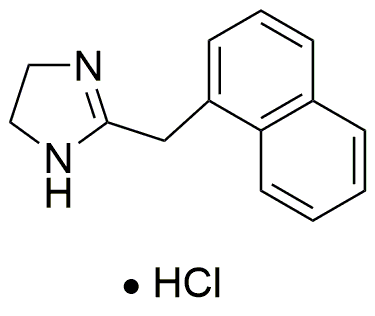Naphazoline hydrochloride is widely utilized in research focused on:
- Ophthalmology: Commonly used as a topical decongestant in eye drops to relieve redness and irritation caused by minor eye irritations.
- Rhinology: Employed in nasal sprays to reduce nasal congestion, making it beneficial for individuals suffering from allergies or colds.
- Pharmaceutical Development: Acts as a model compound in studies aimed at developing new medications for respiratory and ocular conditions.
- Veterinary Medicine: Utilized in certain veterinary applications to alleviate nasal congestion in animals, showcasing its versatility beyond human medicine.
- Research on Drug Interactions: Serves as a reference compound in pharmacological studies to understand interactions with other drugs, aiding in the development of safer therapeutic protocols.
Informations générales
Propriétés
Sécurité et réglementation
Applications
Naphazoline hydrochloride is widely utilized in research focused on:
- Ophthalmology: Commonly used as a topical decongestant in eye drops to relieve redness and irritation caused by minor eye irritations.
- Rhinology: Employed in nasal sprays to reduce nasal congestion, making it beneficial for individuals suffering from allergies or colds.
- Pharmaceutical Development: Acts as a model compound in studies aimed at developing new medications for respiratory and ocular conditions.
- Veterinary Medicine: Utilized in certain veterinary applications to alleviate nasal congestion in animals, showcasing its versatility beyond human medicine.
- Research on Drug Interactions: Serves as a reference compound in pharmacological studies to understand interactions with other drugs, aiding in the development of safer therapeutic protocols.
Documents
Fiches de données de sécurité (FDS)
La FDS fournit des informations de sécurité complètes sur la manipulation, le stockage et l’élimination du produit.
Spécifications du produit (PS)
Le PS fournit une description complète des propriétés du produit, notamment sa composition chimique, son état physique, sa pureté et les exigences de stockage. Il détaille également les plages de qualité acceptables et les applications prévues du produit.
Certificats d'analyse (COA)
Recherchez des certificats d'analyse (COA) en saisissant le numéro de lot du produit. Les numéros de lot et de lot se trouvent sur l'étiquette d'un produit, après les mots « Lot » ou « Lot de fabrication ».
Numéro de catalogue
Numéro de lot/série
Certificats d'origine (COO)
Ce certificat d'exploitation confirme le pays dans lequel le produit a été fabriqué, et détaille également les matériaux et composants utilisés et s'il est issu de sources naturelles, synthétiques ou autres sources spécifiques. Ce certificat peut être requis pour les douanes, le commerce et la conformité réglementaire.
Numéro de catalogue
Numéro de lot/série
Fiches de données de sécurité (FDS)
La FDS fournit des informations de sécurité complètes sur la manipulation, le stockage et l’élimination du produit.
DownloadSpécifications du produit (PS)
Le PS fournit une description complète des propriétés du produit, notamment sa composition chimique, son état physique, sa pureté et les exigences de stockage. Il détaille également les plages de qualité acceptables et les applications prévues du produit.
DownloadCertificats d'analyse (COA)
Recherchez des certificats d'analyse (COA) en saisissant le numéro de lot du produit. Les numéros de lot et de lot se trouvent sur l'étiquette d'un produit, après les mots « Lot » ou « Lot de fabrication ».
Numéro de catalogue
Numéro de lot/série
Certificats d'origine (COO)
Ce certificat d'exploitation confirme le pays dans lequel le produit a été fabriqué, et détaille également les matériaux et composants utilisés et s'il est issu de sources naturelles, synthétiques ou autres sources spécifiques. Ce certificat peut être requis pour les douanes, le commerce et la conformité réglementaire.


